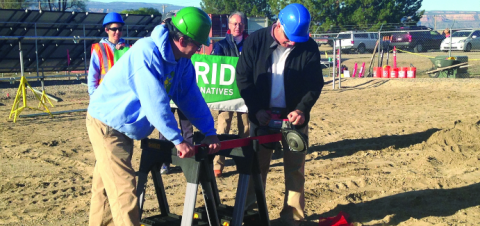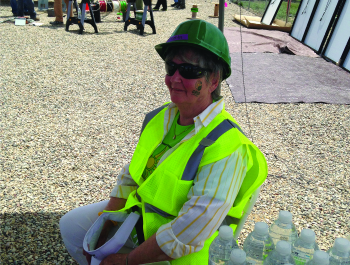Image

Katie Bowman, Executive Director, Housing Resources of Western Colorado
Challenge: Grand Junction, CO, has some of the highest unemployment and poverty rates, and affordable housing and housing services are urgently needed. Low-income residents would greatly benefit from having access to renewable energy sources, but the cost of solar systems puts this resource out of reach.
Grand Junction has some of the highest unemployment and poverty rates in Colorado. It also has a tremendous need for affordable housing and housing services. Low-income families and individuals would greatly benefit from having access to inexpensive, clean renewable energy sources. Unfortunately, the high cost of purchasing and installing solar systems puts this resource out of reach.
For over 35 years, the Housing Resources of Western Colorado (HRWC) has provided affordable housing and quality housing services to low-income families in Grand Junction, also known as the Grand Valley. Part of HRWC’s mission is to promote the wise and sustainable use of resources in Western Colorado. HRWC also serves 12 other counties in Western Colorado through their weatherization, self-help housing, the housing rehabilitation loan program and property rentals programs.
According to the February 2016 City of Grand Junction’s Housing Needs Assessment, unemployment in Grand Junction has fallen over the past few years, but it remains higher than the state average. By June 2015, the unemployment rate in Grand Junction was 7.8 percent, while the state’s rate was 4.5 percent. The 2014 American Community Survey data showed the poverty in the Grand Valley increased to 16.6 percent.
Housing costs are particularly troublesome for low-income households in Grand Junction. Some 35.8 percent of Grand Valley residents were cost burdened, spending more than 30 percent of their income on housing. In addition, some 50.2 percent of renters were cost burdened.
HWRC, Grand Valley Power (GVP), an electric cooperative utility based in Grand Junction, and GRID Alternatives, the nation’s largest non-profit solar installer, developed the solar garden partnership to assist low-income individuals and families in the Grand Valley. GVP, GRID, and volunteers from the community constructed a solar array, consisting of solar panels lined up in rows, much like a garden. The solar panels collect sunlight, which is converted into electricity and transferred to the electric grid.
Eight families in Mesa County are participating in the first community solar garden project in the nation. Each family will continue to pay a utility bill as well as contribute $.02 per kilowatt hour generated by the solar garden and 16 hours of sweat equity to support the project’s development. Families subscribing to the community solar garden will experience saving whether they rent or own their home.
Families are re-qualified every four years for the program. If they have moved outside the GVP service area or their income increases, this will open another spot for a qualifying family. The 29-kilowatt array will generate over $100,000 in electricity bill savings over the next 20 years.
 GRID provided the materials, design and program development expertise to build the solar garden. GVP provided the site, interconnection facilities and administrative support for the project. Additional partners, including local banks, the National Renewal Energy Laboratory, solar companies and other regional companies pitched in. There was also financial help from some of the national solar equipment manufacturers, including SunEdison, Enphase Energy and Iron Ridge.
GRID provided the materials, design and program development expertise to build the solar garden. GVP provided the site, interconnection facilities and administrative support for the project. Additional partners, including local banks, the National Renewal Energy Laboratory, solar companies and other regional companies pitched in. There was also financial help from some of the national solar equipment manufacturers, including SunEdison, Enphase Energy and Iron Ridge.Replication has already begun locally. In February of 2016, GRID began developing a low-income community shared demonstration project in partnership with Delta-Montrose Electric Association (DMeA) and the Colorado Energy Office (CEO). This project will be similar to the Grand Junction solar garden, which should have the capacity to serve approximately 43 low-income households that are DMEA members. CEO is in the process of conducting outreach to solicit subscribers to the system, targeting homes that received weatherization services from 2010 to 2015. A primary goal of the solar garden project is to complement the work CEO is doing to address home heating costs with a program that helps households further reduce their energy bills by addressing electric costs.
One of the eight families participating in the solar garden became interested in applying for the solar garden project from past experience with CEO’s Weatherization Program administered by HRWC. Ms. Riley, a widow on a fixed income, saw significant savings on her energy bills after weatherization was performed on her home three years ago. “I am always looking for ways to save money, and being part of the solar garden has significantly helped me do that. I didn’t pay anything!”
Through this project, HRWC learned that education was key for helping the community, staff, other nonprofits, businesses and the media to understand what a solar array garden was. And because many were skeptical about the program, it was important to have a coordinated response and continuous communication.

